The Palatine Ludwig Railway Company was a German railway concern that was founded to operate the Palatine Ludwig Railway (Ludwigsbahn) in the Palatinate, a region of southwest Germany that was once part of the Kingdom of Bavaria within the German Empire.

The Neustadt–Wissembourg railway, also called the Pfälzische Maximiliansbahn, Maximiliansbahn or just the Maxbahn - is a railway line in southwestern Germany that runs from Neustadt an der Weinstrasse to Wissembourg in Alsace, France. The Palatine Maximilian Railway also included a branch from Winden via Wörth and the Maxaubahn to Karlsruhe.

Neustadt (Weinstr) Hauptbahnhof – called Neustadt a/d. Haardt until 1935 and from 1945 until 1950 – is the central station of in the city of Neustadt in the German state of Rhineland-Palatinate. In addition to the Hauptbahnhof, Rhine-Neckar S-Bahn services stop at Neustadt (Weinstr) Böbig halt (Haltepunkt). Mußbach station and Neustadt (Weinstr) halt, opened on 19 November 2013, are also located in Neustadt.

Landau (Pfalz) Hauptbahnhof is the centre of public transport in the city of Landau in the German state of Rhineland-Palatinate.

The Schifferstadt–Wörth railway or Speyer line is a uniformly double track and electrified main line in the German state of Rhineland-Palatinate. Between Schifferstadt and Germersheim it is part of the network of the Rhine-Neckar S-Bahn. Between Germersheim and Wörth am Rhein it is part of the network of the Stadtbahn Karlsruhe.

Germersheim station is a junction station in the town of Germersheim in the German state of Rhineland-Palatinate. Deutsche Bahn classifies it as a category 5 station and it has four platform tracks. The station is located in the network of the Karlsruher Verkehrsverbund and belongs to fare zone 575. Since 1996, Germersheim has also been part of the area where the tickets of the Verkehrsverbund Rhein-Neckar are accepted at a transitional rate. The address of the station is Bahnhofstraße 13.

The Landau–Rohrbach railway is a major line running from Landau in the German state of Rhineland-Palatinate to Rohrbach in the Saarland. The main section between Landau and Zweibrücken was opened on 25 November 1875 after the first sections had already been opened between 1857 and 1867.
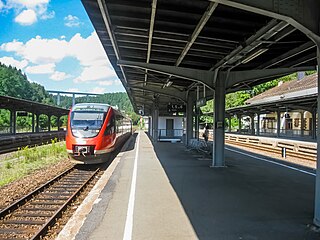
Pirmasens Nord (north) station is a station opened in 1875 seven kilometres north of Pirmasens in the municipality of Thaleischweiler-Fröschen in the German state of Rhineland-Palatinate. The station is located next to the hamlet of Biebermühle, which it was named after until 1936. It is the main station within the district of Südwestpfalz.

Enkenbach station is the only station in Enkenbach-Alsenborn in the German state of Rhineland-Palatinate. It has two platforms tracks and is located in the network of the Verkehrsverbund Rhein-Neckar and belongs to fare zone 828. Its address is Bahnhofstraße 2.

The Winden–Karlsruhe railway is a mainline railway in the German states of Baden-Württemberg and Rhineland-Palatinate, which in its present form has existed since 1938 and is electrified between Wörth and Karlsruhe. The current Winden–Wörth section was opened in 1864. A year later, the gap between the Rhine and the Maxau Railway (Maxaubahn), which had been opened in 1862, was closed. The route of the latter was changed during the relocation of the Karlsruhe Hauptbahnhof. New sections of the line were also built between Wörth and Mühlburg mainly in connection with the commissioning of a fixed bridge over the Rhine.

Wörth (Rhein) station—originally Wörth (Pfalz)—is the most important station of the town of Wörth am Rhein in the German state of Rhineland-Palatinate. Deutsche Bahn classifies it as a category 5 station and it has five platforms. The station is located in the area of the Karlsruher Verkehrsverbund and it belongs to fare zone 540. Since 2001, Verkehrsverbund Rhein-Neckar (VRN) tickets are also accepted for travel to or from the VRN area. The address of the station is Bahnhofstraße 44.
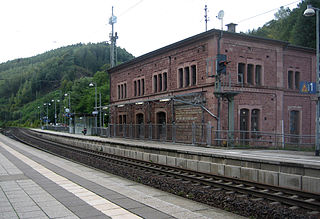
Frankenstein (Pfalz) station is the station of the town of Frankenstein in the German state of Rhineland-Palatinate. Deutsche Bahn classifies it as a category 6 station and it has two platforms.

Weidenthal station is the station of the town of Weidenthal in the German state of Rhineland-Palatinate. It lies on the Mannheim–Saarbrücken railway, which essentially consists of the Pfälzischen Ludwigsbahn, which historically connected Ludwigshafen and Bexbach. It was opened on 25 August 1849, with the Kaiserslautern–Frankenstein section of the Ludwig Railway. Its entrance building is a protected monument.

Lambrecht (Pfalz) station is the station of the town of Lambrecht in the German state of Rhineland-Palatinate. Deutsche Bahn classifies it as belonging to category 4 and it has three platform tracks. The station is located in the network of the Verkehrsverbund Rhein-Neckar and belongs to fare zone 121. Its address is Bahnhofstraße 4.
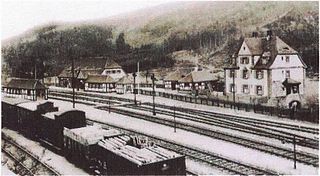
Hinterweidenthal Ost station is one of a total of three stations in the municipality of Hinterweidenthal in the German state of Rhineland-Palatinate. Deutsche Bahn classifies it as a category 6 station and it has two platform tracks. The station is located in the network of the Verkehrsverbund Rhein-Neckar and belongs to fare zone 998.
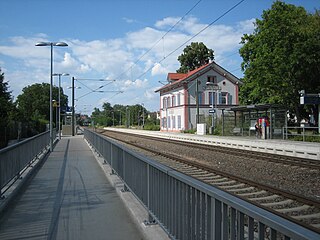
Sondernheim station is a station in the Germersheim suburb of Sondernheim, in the German state of Rhineland-Palatinate. Deutsche Bahn classifies it as a category 6 station and it has two platform tracks. The station is located in the network of the Karlsruher Verkehrsverbund and belongs to fare zone 575. Since 2001, the station has also been part of the area where the fares of the Verkehrsverbund Rhein-Neckar are accepted at a transitional rate. The address of the station is Germersheimer Straße 14. Its former entrance building is under heritage protection.

Bellheim station is a station in the village of Bellheim in the German state of Rhineland-Palatinate. Deutsche Bahn classifies it as a category 6 station and it has two platform tracks. The station is located in the network of the Karlsruher Verkehrsverbund. Since 2001, the station has also been part of the area where the fares of the Verkehrsverbund Rhein-Neckar are accepted at a transitional rate. The address of the station is Bahnhofstraße 8.

Rülzheim station is a station in the town of Rülzheim in the German state of Rhineland-Palatinate. The original station was opened on 25 July 1876 with the commissioning of the Germersheim–Wörth section of Schifferstadt–Wörth railway. The address of the old entrance building, which is heritage listed, is Bahnhofstraße 6.

Rheinzabern station is the main station in the town of Rheinzabern in the German state of Rhineland-Palatinate. Deutsche Bahn classifies it as a category 6 station and it has two platform tracks. It is located on the network of the Karlsruher Verkehrsverbund. Since 2001, the station has also been part of the area where the fares of the Verkehrsverbund Rhein-Neckar are accepted at a transitional rate. Its address is Bahnhofstraße 26.
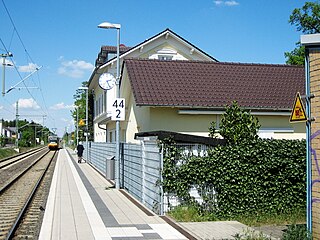
Jockgrim station is the only station in the town of Jockgrim in the German state of Rhineland-Palatinate. Deutsche Bahn classifies it as a category 6 station and it has two platform tracks. It is located on the network of the Karlsruher Verkehrsverbund and belongs to fare zone 555. Since 2001, the station has also been part of the area where the fares of the Verkehrsverbund Rhein-Neckar are accepted at a transitional rate. Its address is Am Bahnhof 1.




























